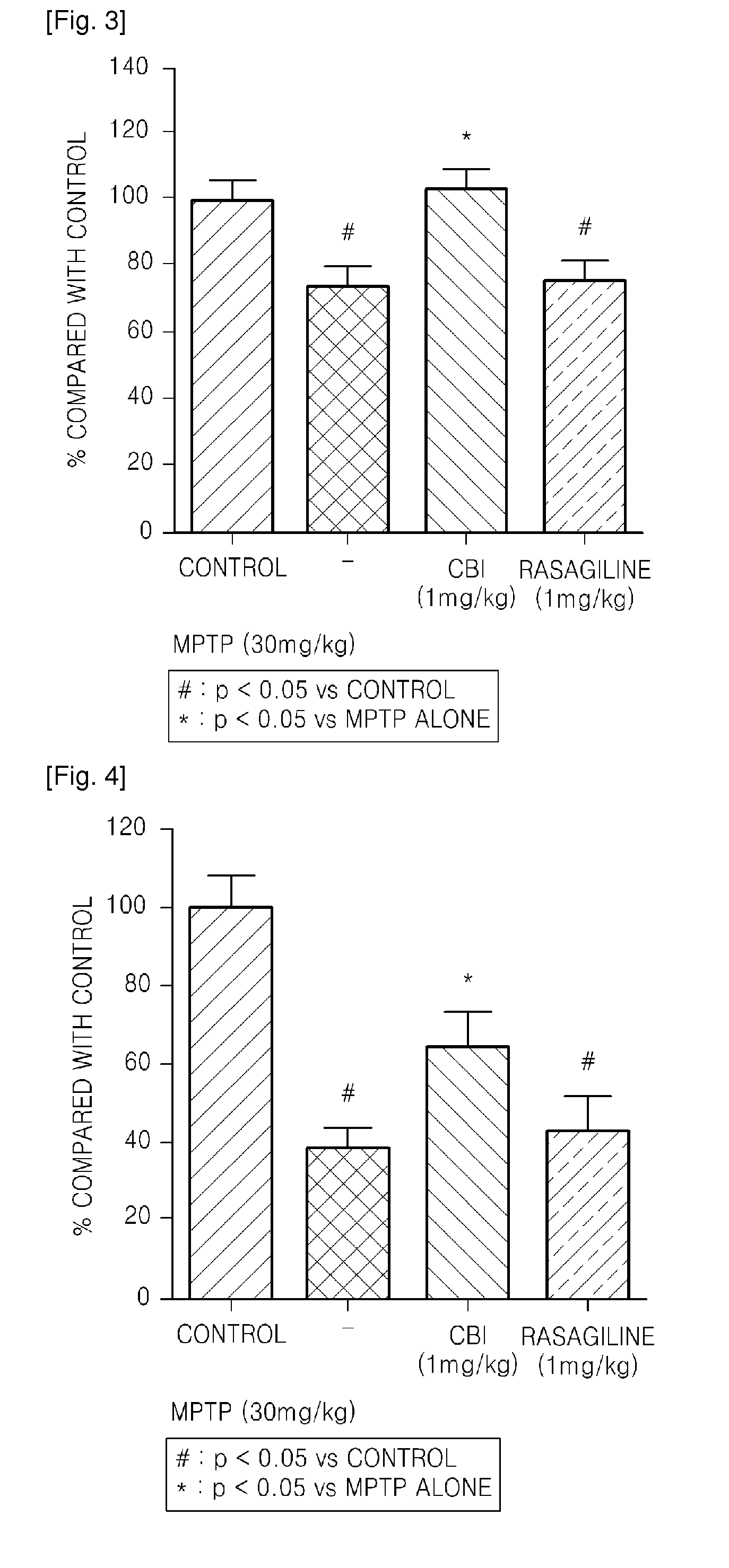Pharmaceutical composition for inhibiting apoptosis of neuron or neurodegeneration
a technology of apoptosis inhibition and pharmaceutical composition, which is applied in the direction of drug compositions, biocide, cardiovascular disorders, etc., can solve the problems that the drugs that effectively inhibit the apoptosis of neurons or neurodegeneration are not commercially available, and achieve the effects of meaningful behavioral loss, reduced neuronal damage, and improved neuronal function
- Summary
- Abstract
- Description
- Claims
- Application Information
AI Technical Summary
Benefits of technology
Problems solved by technology
Method used
Image
Examples
example 1
Preparation of carbamic acid 3-(4-benzyloxy-phenyl)-isoxazole-5-yl methyl ester (Formula II)
[0089]
1.1. Synthesis of 4-benzyloxy-benzaldehyde oxime
[0090]4.24 g of 4-benzyloxy benzaldehyde (20 mmol) was dissolved in a 0.2M mixed solution of ethanol and water (3:1,100 ml), followed by stirring. 2.78 g of NH2 OH-HCl (40 mmol) and 2.46 g of sodium acetate(30 mmol) were added thereto, and stirred at room temperature for about 30 minutes. Subsequently, the completion of the reaction was confirmed by liquid chromatography, and water and ethanol were removed by distillation under reduced pressure to obtain a pale yellow solid compound. The pale yellow solid compound was extracted three times with water and ethyl acetate, an organic solvent layer was dried under reduced pressure to obtain a crude product, and the crude product was then purified with a hexane / ethylacetate solution (10:1) to obtain a white solid compound. The obtained solid compound was subjected to subsequent reactions without...
example 2
Confirmation of Neuroprotective effect of CBI by Using MPTP-Induced Monkey
[0095]1-methyl-4-phenyl-1,2,3,6-tetrahydropyridine (MPTP) is reported to induce clinical, biochemical and pathologic characteristics similar to those observed in patients with Parkinson's disease, and is known as a neurotoxin that is widely used in preparing an animal model for Parkinson's disease in rodents and primates (J. Neural Transm., 103:987-1041(1996); Neurotoxicol. Teratol. 24:607-620(2002)). MPTP is converted to 1-methyl-4-phenyl-pyridinium (MPP+) by monoamineoxidase(MAO)-B, and MPP+ has a high affinity for the dopamine transporter(DAT) and induces dysfunction of mitochondria and oxidativestress, resulting in apoptosis of dopaminergic neurons that induce the formation of dopamine(J. Neurochem.,61:1191-1206(1993); J. Neural Transm., 103:987-1041(1996); Mov. Disord., 13:35-38(1998); Restor. Neurol. Neurosci., 16:135-142(2000)).
[0096]Macaque monkeys (n=35, 3 to 4-year-old) were used as an experimental ...
example 2-1
Measurement of the Extent of Parkinson's Disease
[0097]The extent of Parkinson's disease was measured by analyzing videotaped behaviors of each group of monkeys, based on four standards: a) range of movement, b) hypokinesia, c) extent of abnormal posture, and d) tremor. A Parkinson's disease score was evaluated by the sum of (4-range of movement)+hypokinesia+extent of abnormal posture+tremor. Hence, the maximum value of the total Parkinson's disease score is 10. The Parkinson's disease score was measured for 10 minutes every 30 minutes through 2 hours. That is, the maximum value of the highest Parkinson's disease score is 40. Meanwhile, the measurement method performed based on the four standards was as follows, and evaluated scores below represent representative behaviors observed through observation periods:
[0098]a) Score of the range of movement: 0=no movement; 1=only movement of head; 2=movement of head, limbs and / or body without exercise no shorter than 30% of the observation ti...
PUM
| Property | Measurement | Unit |
|---|---|---|
| temperature | aaaaa | aaaaa |
| height | aaaaa | aaaaa |
| height | aaaaa | aaaaa |
Abstract
Description
Claims
Application Information
 Login to View More
Login to View More - R&D
- Intellectual Property
- Life Sciences
- Materials
- Tech Scout
- Unparalleled Data Quality
- Higher Quality Content
- 60% Fewer Hallucinations
Browse by: Latest US Patents, China's latest patents, Technical Efficacy Thesaurus, Application Domain, Technology Topic, Popular Technical Reports.
© 2025 PatSnap. All rights reserved.Legal|Privacy policy|Modern Slavery Act Transparency Statement|Sitemap|About US| Contact US: help@patsnap.com



